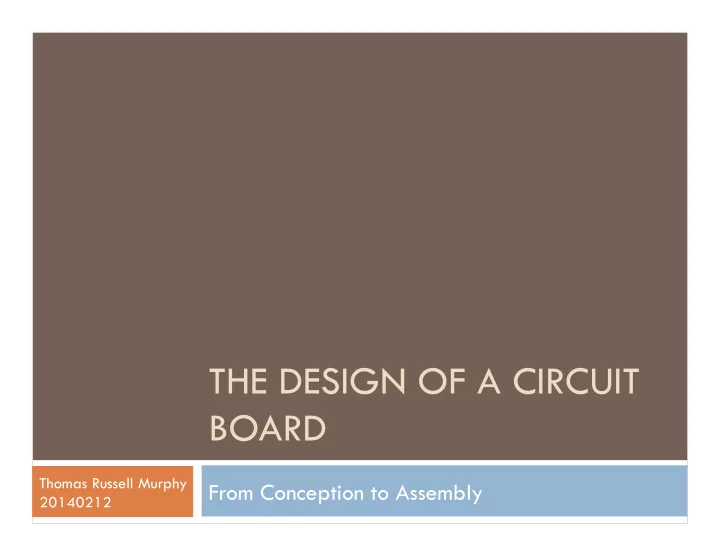

THE DESIGN OF A CIRCUIT BOARD Thomas Russell Murphy From Conception to Assembly 20140212
Overview of Process ¨ Development of Specifications ¨ Schematic Capture ¨ Layout and Component Definition ¨ Prototype Manufacturing ¨ Software Options ¨ +Demonstrations of gEDA and Rev. 1 Product
Development of Specification ¨ What do you want your board to do? ¨ How will it communicate with any desired peripherals or output devices? ¨ Choose core components and interfaces ¨ Complete at least a block-level schematic of the layout between onboard devices and their interfaces
Schematic Capture ¨ Interconnection of components ¨ Need to have symbols to represent each component being used in the design ¨ Fulfillment of specifications ¨ Need to define initial power layout: supply, regulated rails, decoupling capacitors ¨ End: All connections made, Bill of Materials completed
Layout: Footprints and Form Factors ¨ Before the connections (netlist) from your schematic are useful, you have to know what the components your are using look like ¨ Need to look forward: some parts may be difficult or impossible to hand prototype ¨ Need accurate layouts: if something is critical and you didn’t pay for it with support , you need to verify an existing design or DIY ¨ MIT Student: “To whoever uses the Sparkfun eagle library for a Nokia LCD footprint: the pins are reversed!” http://fab.cba.mit.edu/classes/MIT/863.09/people/gershon/final_project.html
Integrated Circuits: TSSOP RQFP SO SSOP QFN Surface mount devices are the present. While some components may be through- hole, the logic of the board will likely be SMDs. All of these can be used in hand- assembled prototypes, though QFN requires special work. https://commons.wikimedia.org/wiki/File:TSSOP_RQFP_SO_SSOP_QFN.jpg
High Density Connections: Ball Grid Array A soldering iron will no longer do. Assembling a board with a BGA part will require reflow in a temperature controlled oven. This part may also need to be machine-positioned to accurately place it on the board. https://en.wikipedia.org/wiki/File:Kl_Intel_Pentium_MMX_embedded_BGA_Bottom.jpg
Some Standardized Footprints QFN56_8_EP TSSOP56N These are probably safe to work with for JEDEC standard part footprints.
Layout: Designing the Connections ¨ Implementing the connections between components ¨ Optimizing graph of the netlist with wires ¨ Greater density of connections requires more layers to efficiently complete the network ¨ Need to consider trace lengths and configurations ¨ Varying requirements for connections: low-resistance power, ground planes, integrity of high-frequency signals, matching
Layout: Complexity Options ¨ Everything determined by manufacturer ¨ Layers of board: 1, 2, 4, and higher ¨ Substrate material, thickness: FR4, ceramic ¨ Copper plating: 0.5, 1, 2, 3 oz/sq. ft ¨ Manufacturing parameters: trace size, copper spacing, annular ring width, drill sizes, board cutting/routing
Manufacturing a Prototype ¨ Cost is proportional to all of quality, speed, product complexity, and board features ¨ Without in-house manufacturing, a PCB will easily take >2 weeks to arrive for assembly ¨ Medium quality, fast, low complexity, bare minimum features: ThinkBox Router ¨ Complete: medium-high quality, 2+ weeks, low to medium complexity, standard features: Osh Park, Advanced Circuits
Hand Assembly of Board ¨ Through-hole only: solder with lab stump-tip irons ¨ SMD ~1mm/50mil: solder with a fine-tipped iron ¨ SMD smaller: solder with fine-tipped iron, viewing with a microscope ¨ Large-pad chips or BGA: good luck reflowing with a hot plate and a hot air source
The Gist of Production ¨ http://www.bunniestudios.com/blog/?p=2407 ¨ Need to order tape-on-reel parts (1-5k per reel) ¨ 1x1.5 meter raw copperclad FR-4 ¨ Massive drilling machines ¨ Long series of automated chemical tanks ¨ Boards from one place, assembly elsewhere ¨ Overall, not a simple task
Production of Boards: Etching Phase Some video from the blog post on the production of Arduino boards. This shows off the automation and scale required.
Additional Assembly Options ¨ Better and faster than tweezer-placement ¨ Apply solder paste and adhesive to board ¨ Manual pick-and-place: load reel of components and control X,Y placement by hand ¨ Automated pick-and-place: load reels of components, panelized boards, and part positioning information ¨ Follow with small or large reflow oven to make connections
Software (Complete EDA) ¨ No good news here ¨ FOSS: gEDA (gschem, pcb, utilities), KiCAD ¨ Crippled Freeware: EAGLE Light Edition ¨ Enthusiastic hobbyist, Student Edition, something for support on a budget: ???? ¨ Production Enterprise ($$$): Altium Designer, EAGLE
A Brief Demonstration ¨ gEDA: Building a really simple board
Recommend
More recommend